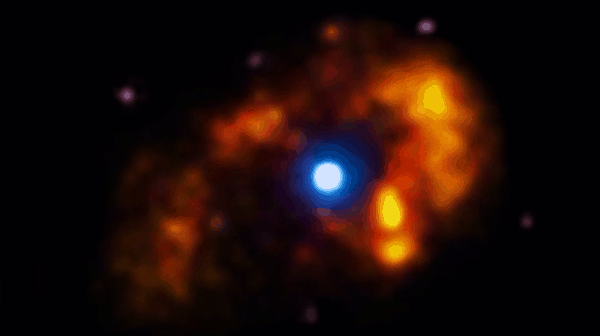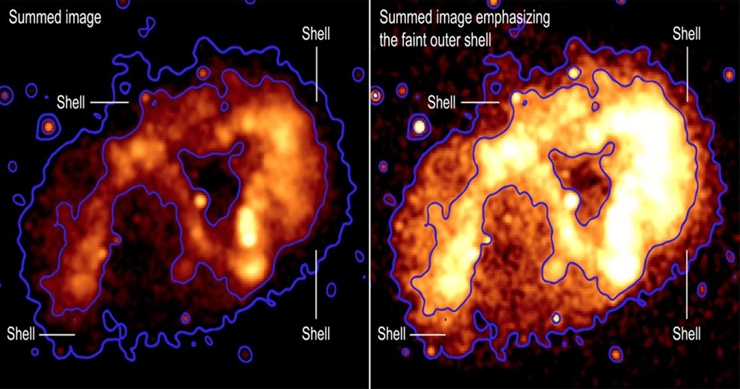Astronomers have created a video using over two decades of data from NASA’s Chandra X-ray Observatory, revealing the expansion of a stellar eruption that occurred around 180 years ago. The eruption, known as Eta Carinae, involves a star system containing two massive stars. The explosion, referred to as the “Great Eruption,” is thought to have resulted from the merging of two stars from a triple star system. The aftermath of this collision was observed on Earth in the mid-19th century.

The eruption from Eta Carinae ejected between 10 and 45 times the mass of the sun, forming a dense pair of spherical clouds of gas, known as the Homunculus Nebula, on opposite sides of the two stars. The Homunculus Nebula is a bright blue cloud at the center of the image, fueled by high-energy X-rays produced by the two massive stars. These stars are surrounded by a bright orange ring of X-ray emissions that appear to grow and expand rapidly over time.
The new video reveals important hints about Eta Carinae’s volatile history, including the rapid expansion of the ring, and a previously-unknown faint shell of X-rays outside it. Based on the motion of gas clumps, astronomers believe the stellar material was blasted away from Eta Carinae sometime between the years 1200 and 1800. As the blast extended into space, it collided with interstellar material in its path. This collision heated the material, creating the bright X-ray ring observed. However, the blast wave has now traveled beyond the ring, causing the X-ray brightness of Eta Carinae to fade with time.
The findings on Eta Carinae’s expansion were published in a 2022 study in the Astrophysical Journal. Michael Corcoran, who led the study at NASA’s Goddard Space Flight Center, interprets the faint X-ray shell as the blast wave from the Great Eruption in the 1840s. The shell provides an important part of Eta Carinae’s backstory that was previously unknown.
Key Takeaways:
- Astronomers have used two decades of data from NASA’s Chandra X-ray Observatory to create a time-lapse video of a stellar eruption that occurred about 180 years ago in the Eta Carinae star system.
- The eruption, known as the “Great Eruption,” resulted from the merger of two stars and has been expanding into space at speeds up to 4.5 million miles per hour, ejecting between 10 and 45 times the mass of the sun.
- The scientists’ findings, which provide important insights into Eta Carinae’s volatile history, were published in a 2022 study in the Astrophysical Journal.
“Using over two decades of data from NASA’s Chandra X-ray Observatory, astronomers have crafted a stunning new video of a stellar eruption that took place some 180 years ago. The time-lapse video uses Chandra observations from 1999, 2003, 2009, 2014 and 2020 — along with data from ESA’s XMM-Newton spacecraft — and retraces the history of the stellar explosion known as Eta Carinae.”
More details: here


Leave a Reply